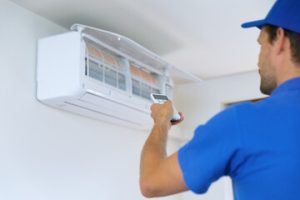When your air conditioning system starts to make strange noises or not work at all, it’s time for a repair. Air conditioner problems can be costly and should be fixed right away to prevent further damage.
Unusual noises may indicate a problem with the compressor, fan motor or ductwork. Pooled water around the unit could mean a clogged condensate drain line or dirty evaporator coils. Contact AC Repair Round Rock for professional help.
1. Unusual Noises

Strange AC sounds are the system’s way of telling you something is off. Ignoring them puts your system at risk of higher repair bills and even complete breakdowns when you need cooling the most. The best thing to do when you hear unusual noises is to call a professional immediately.
A gentle humming sound may be normal, but if it grows louder or doesn’t stop, it’s time to call a technician. The humming may be caused by loose wires, failing capacitors, or problems with the fan or motor. If the humming isn’t caused by any of these issues, it could be due to blocked or dirty air vents or ductwork.
Clicking is another common AC noise that should never be ignored. It usually indicates that the thermostat or control panel is having problems operating properly. If the clicking is accompanied by other malfunctions like startup problems or short cycling, it’s a good idea to call a professional right away.
Screeching sounds are typically the result of worn or damaged fan belts, blower motor bearings, or other mechanical issues. If the problem is not addressed promptly, the belts or motor can break down completely, requiring a costly replacement.
Routine maintenance can prevent many of these everyday AC sounds from occurring in the first place. Cleaning the evaporator coils, replacing air filters, and having the system professionally inspected can help keep the equipment running safely for its full lifespan.
2. Water Leaks
If you notice water leaking from your AC unit, shut it off immediately and call a professional. Left unchecked, AC leaks can cause extensive damage and lead to mold growth. There are several common reasons for a leak, including clogged drain lines, frozen coils, or a damaged drain pan. An experienced technician can diagnose the problem and repair it to prevent further problems.
If your air conditioner has a clogged drain line, it can cause a water leak. The drain line transports condensation from the unit to the outside, but it can become blocked with dirt, dust, algae, and other debris over time. When the line clogs, the water has nowhere to go and backs up into your house. If you suspect a clog, try flushing the line with a solution of equal parts vinegar and water. If this doesn’t work, you may need a wet-dry vacuum or plumber’s snake to clear the line.
A clogged drain line can also be caused by an improper installation. If the line was installed too low, it can cause the condensate pump to overflow and create a leak. Another potential problem is a disconnect between the evaporator coil and the drain pan. This can also cause a backup of water.
To avoid AC leaks, commit to a regular maintenance schedule. Schedule annual tune-ups with a certified technician to have your system professionally cleaned and to check for refrigerant leaks or a clogged evaporator coil. In addition to replacing the air filter regularly, the technician will clean the drain line and the evaporator coils to keep them from getting dirty or clogged. They will also monitor refrigerant levels and address any cooling issues before they can turn into significant AC leaks.
3. Low Airflow
On a hot summer day, it’s frustrating to turn on your AC and find out that it’s only blowing a whisper of cool air. A professional will check for issues like a dirty filter or blockage in the vents and ducts to fix them so that your home can breathe easy again.
Depending on the issue, it may be possible to solve it yourself by clearing away buildup from registers or a blockage in the condenser unit itself (which is typically outside). You can also try switching between fresh air and recirculate settings to see if this changes your AC’s ability to pull in air.
If the above tips don’t help, you should call for an inspection and repair service right away. An AC technician will ensure that your system is the proper size for your home based on square footage, ceiling height, insulation type, window types, if you have a basement or slab, etc. Having an AC unit that is too small can cause it to overwork itself, which leads to low airflow and other problems.
An HVAC professional can also check your ductwork for blockages or leaks, which can be tricky to spot. Narrow ducts, holes and gaps, rodents, bird nests or even just dirt or dust can all inhibit airflow through your ductwork.
A system that is working with low airflow or a refrigerant leak will be under a constant strain, leading to overheating and a much higher utility bill than usual. Taking care of these issues early will save you money and frustration down the road.
4. Pooled Water Around the Unit
There’s nothing to be ashamed of when you can handle a few home repairs, such as replacing the washer on your faucet or tightening the latch on a window that doesn’t open anymore. However, there are some issues that should be left to the professionals—and one of those is a malfunctioning air conditioner.
You’ll need AC repair if your unit shuts off or won’t turn on at all, especially if it does so repeatedly. A faulty electrical connection or an overload of power to the system can cause the circuit breakers to trip, and a trained HVAC contractor can help you identify the problem.
The coolant lines running from the condenser outside to the evaporator inside your house are insulated for efficiency, and if the insulation is damaged or worn out, it will reduce cooling effectiveness. A skilled HVAC contractor can replace the insulation and restore the AC’s efficiency.
If you notice pools of water around the unit, it’s likely due to poor drainage. An experienced HVAC contractor can help you improve the grading and reduce moisture levels to prevent damage and keep your home comfortable.
A functioning air conditioning system is a necessity in Central Pennsylvania, but you’ll need to know when it’s time to call for professional AC repair to ensure optimal performance and longevity. Understanding the difference between AC repairs and maintenance can empower you to take proactive measures and schedule regular service visits, avoiding costly and inconvenient repair services down the road. Trust the professionals at Shipton’s Heating & Cooling Ltd to diagnose and repair your AC system, so you can enjoy cool comfort all summer long. Learn more about our AC repair and maintenance services by contacting us today.
5. Unusual Smells
Unusual smells can signal a problem with your air conditioning system. If you notice a musty or earthy odor coming from your vents, it’s a sign of mildew and mold buildup within the system or dampness in the ductwork. This irritates indoor air quality and exacerbates allergies and respiratory issues. In most cases, the odor can be eliminated with routine cleanings by an AC repair professional.
A burning smell is a serious warning that indicates an electrical issue within your unit, possibly due to overheating wires or components. A professional can determine if this is a simple fix or a potential safety issue that requires immediate attention.
If you notice an odor that reminds you of dirty gym socks, it may indicate an overgrowth of bacteria or mold on the evaporator coil. This condition, known as “Dirty Sock Syndrome,” reduces indoor air quality and triggers allergy and asthma symptoms. A professional will clean the evaporator coil and remove any mildew or bacteria.
In some cases, you might notice an odor similar to rotten eggs. If so, it’s likely that a pest has found shelter in your ductwork and died. This odor can be quite unpleasant and should be addressed immediately.
When you detect any unusual odors, turn off your AC system immediately. This will prevent further damage and help you determine if the problem is minor or major. Then, you can contact a professional for AC maintenance and repair in Haysville to keep your home cool all summer long. To learn more, contact MJB Heating & Cooling today. We provide fast, effective AC repairs and maintenance services that can help you enjoy a comfortable home all season long.





